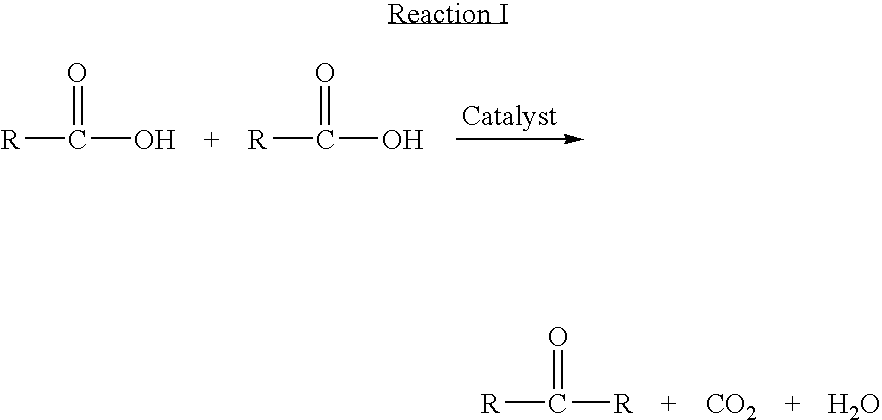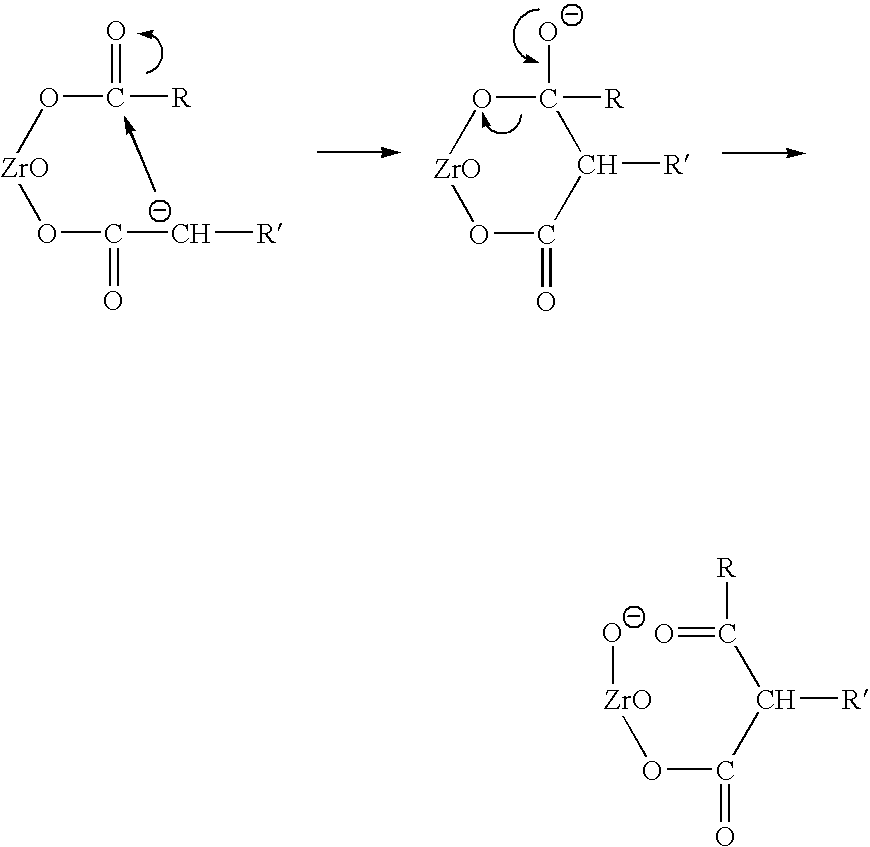Catalyst and process for the preparation of unsymmetrical ketones
a technology of unsymmetrical ketones and catalysts, applied in the preparation of carbonyl compounds, physical/chemical process catalysts, metal/metal-oxide/metal-hydroxide catalysts, etc., can solve the problems of affecting the catalytic performance of the catalyst, and unable to achieve the effect of reducing the number of unsymmetrical ketones
- Summary
- Abstract
- Description
- Claims
- Application Information
AI Technical Summary
Benefits of technology
Problems solved by technology
Method used
Image
Examples
example 1
Ketone Screening Reactors
[0062] The equipment for these experiments was a one inch diameter 304 stainless steel tube two feet in length heated with a Series 3210 Applied Test Systems 2 kilowatt reactor operating at temperatures of 200 to 700° C. + / −5° C. The catalyst was weighed and introduced as¼ inch diameter pellets filling about one third of the reactor topped with a 6 inch bed of 8 mm glass beads to help vaporize the liquid feed. A calibrated series 33 Harvard syringe pump was used to introduce the feed at a pre-determined rate. Screening experiments generally ran 4-8 hours to ensure a consistent product. Catalyst lifetime studies required several hundred hours of continuous operation. These experiments were aided by use of a Camille automated computer system to control the experiments.
[0063] Analyses were completed using a Varian 6890 gas chromatograph equipped with a 30 meter DB-5 capillary column and calibrated using authentic samples of the different products. The results...
example 2.1
Potassium Base Modified Zirconia Catalyst—Exchange Preparation
[0064] The charge to a 250 milliliter round bottom flask equipped with a Teflon coated stirring bar and blanketed with an inert nitrogen atmosphere throughout the reaction was 100 cubic centimeters of Norton XZ 16075 ¼inch diameter Zirconia pellets (bulk density=1.017 grams per cubic centimeter, 101.7 grams, 51 square meters per gram surface area). To this material was added sufficient 10 weight percent aqueous potassium hydroxide solution to just cover the pellets (75 milliliters solution). Immediately after mixing the temperature of the mixture rose to 450° C. but quickly subsided thereafter. To ensure complete contact, a vacuum (40 millimeters mercury) was drawn on the mixture followed by its release through admitted nitrogen a total of three times. After the last vacuum treatment, the two components were allowed to stand together for 48 hours catalyst before workup.
[0065] The workup consisted of decanting the spent ...
example 2.2
Calcium Base Modified Zirconia Catalyst—Incipient Wetness Preparation
[0066] The charge to the 250 milliliter round bottom flask equipped with a Teflon coated stirring bar and blanketed with nitrogen was 100 milliliters of Norton XZ 16075 ¼ inch diameter pellets (bulk density=1.017. 101.7 grams, surface area=51 square meters per gram). To this slowly rotating material was added dropwise a 10.1 weight percent solution of calcium acetate in water (0.67 M). This treatment continued till the solid material would absorb no more solution and there was evidence of liquid beginning to appear in the bottom of the flask. This treatment required 46.5 milliliters of the solution. The total calcium acetate incorporated was 4.93 grams.
[0067] The workup consisted of removing as much water as possible using a rotary evaporator operating at 10 millimeters mercury vacuum and at a temperature ramping up to 100° C. over two hours. This treatment removed 37.0 milliliters of water. The residual water wa...
PUM
| Property | Measurement | Unit |
|---|---|---|
| Temperature | aaaaa | aaaaa |
| Temperature | aaaaa | aaaaa |
| Temperature | aaaaa | aaaaa |
Abstract
Description
Claims
Application Information
 Login to View More
Login to View More - R&D
- Intellectual Property
- Life Sciences
- Materials
- Tech Scout
- Unparalleled Data Quality
- Higher Quality Content
- 60% Fewer Hallucinations
Browse by: Latest US Patents, China's latest patents, Technical Efficacy Thesaurus, Application Domain, Technology Topic, Popular Technical Reports.
© 2025 PatSnap. All rights reserved.Legal|Privacy policy|Modern Slavery Act Transparency Statement|Sitemap|About US| Contact US: help@patsnap.com


